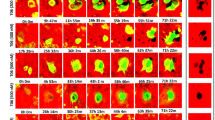Abstract
A morphological investigation has been carried out on the osteoclastic activity revealed by a fungus of theMucor genus on buried bone. The hallmark of its activity in eroding bone is the finding of resorption pits and boring channels whose walls are sharp and well calcified up to the free edge, suggesting that bone resorption affects crystallites and the organic matrix simultaneously. Unlike normal osteoclastic cells, the fungal membrane in contact with the bone shows no brush border. As the electron microscope reveals no migration of material to the fungal membrane and its protoplasm, the view is expressed that the material which reaches the fungus has been previously solubilized. There is good reason for supposing that a substance capable of solubilizing the inorganic bone fraction spreads freely through bone tissue, decalcifying the matrix, where, but only where, hyphae show the effects of ageing. All the findings are thoroughly discussed and compared with those furnished by the boring channels in fossil bone.
Résumé
L'action ostéoclasique exercée par un champignon appartenant au genreMucor sur des os inhumés a été étudiée au point de vue morphologique. L'érosion ossuse donne lieu à des cavités et à des canalicules de percement, dont les parois apparaissent régulièrement calcifiées jusqu'a l'interface avec le champignon, ce qui veut dire que la réabsorption intéresse en même temps la matrice organique et les cristallites. Au contraire des ostéoclastes, la membrane du champignon ne montre jamais un bord en brosse au niveau des points où elle se met en contact avec le tissu osseux. De même l'examen au microscope électronique ne décele apparemment aucun passage de matériel dans l'épaisseur de la membrane ainsi que dans le protoplasme du champignon, ce qui porte à admettre qu'un processus de solubilisation a lieu au préalable. Seulement dans le cas où le champignon présente des phénomènes de vieillissement, des données font prévoir la libération d'une substance capable de décalcifier la matrice organique. Tous les résultats ci-dessu sont discutés de façon analytique et comparés à ceux fournis par les canalicules de percement des os fossiles.
Zusammenfassung
Die osteoklastische Aktivität eines der Mucor-Gattung angehörenden Pilzes auf begrabene Knochen wurde morphologisch untersucht. Die Wirkung dieses Pilzes in der Knochenerosion führt zu Resorptionshöhlen und Bohrkanälen, deren Wände scharf und bis zur Oberfläche gut verkalkt sind; das bedeutet, daß die Knochenresorption gleichzeitig die Kristalliten und die organische Matrix in Mitleidenschaft zieht. Im Gegensatz zu den normalen Osteoklasten zeigt die Membran des Pilzes an den Berührungsstellen mit dem Knochengewebe keinen Bürstensaum. Ebenfalls läßt eine elektronenmikroskopische Untersuchung keinen Durchgang von Substanzen durch die Membran und das Protoplasma des Pilzes erkennen, so daß man annehmen muß, daß vorher ein Auflösungsprozeß stattgefunden hat. Die Vermutung liegt nahe, daß eine Substanz, welche den anorganischen Knochenanteil aufzulösen vermag, sich
Similar content being viewed by others
References
Baker, R. D.: Mucormycosis. In: Handbuch der speziellen pathologischen Anatomie und Histologie, Bd. III/5, Hrsg. E., Uehlinger S. 832–918. Berlin-Heidelberg-New York: Springer 1971
Banker, B. Q.: Cerebral vascular disease in infancy and childhood. I. Occlusive vascular diseases. J. Neuropath. exp. Neurol.20, 127–140 (1961)
Gascoigne, J. A., Gascoigne, M. M.: Biological degradation of cellulose. London: Butterworths 1960
Goodman, J., Rothstein, A.: The active transport of phosphate into the yeast cell. J. gen. Physiol.40, 915–923 (1957)
Johnston, I. R.: The composition of the cell wall of Aspergillus niger. Biochem. J.96, 651–658 (1965)
Korringa, P.: Recent advances in oyster biology. Quart. Rev. Biol.27, 266–308, 339–365 (1952)
Lubbe, T. R., Amborg, M. D. H., Pennington, J. S.: Orbital mucormicosis. Med. J. Aust.51/1, 681–683 (1964)
Mehta, Y. R., Bhide, V. P.: Solubilization of tricalcium phosphate by some soil fungi. Indian J. exp. Biol.8, 228–229 (1970)
Morganthaler, P. W., Baud, C.-A.: Sur une cause d'altération des structures dans l'os humain fossile. Bull. Soc. Suisse Anthrop. et Ethnol.33, 9–10 (1956–1957)
Nickerson, W. J.: Molecular bases of form in yeasts. Bact.27, 305–324 (1963)
Paquin, R., Coulombe, L. J.: Peptic enzyme synthesis in relation to virulence inFusarium oxysporum f.lycopersici (Sacc.), Snyder and Hansen. Canad. J. Bot.,40, 533–541 (1962)
Phaff, H. J.: Cell wall of yeasts. Ann. Rev. Microbiol.17, 15–30 (1963)
Rothstein, A.: Uptake and translocation. In: The fungi, an advanced treatise, eds. G. C. Ainsworth and A. S. Sussman, vol. I, p. 429–455. New York-London: Acad. Press 1965
Roux, W.: Über eine im Knochen lebende Gruppe von Fadenpilzen (Mycelites ossifragus). Z. wiss. Zool.45, 227–254 (1887)
Schaffer, J.: Über den feineren Bau fossiler Knochen. S.-B. Akad. Wiss. Wien, math.-nat. Kl. (III)98, 319–382 (1889)
Schaffer, J.: Über Roux'sche Kanäle in menschlichen Zähnen. S.-B. Akad. Wiss. Wien, math.-nat. Kl. (III)99, 146–152 (1890)
Schaffer, J.: Bemerkungen zur Geschichte der Bohrkanäle in Knochen und Zähnen. Anat. Anz.10, 459–464 (1894)
Sergi, S., Ascenzi, A., Bonucci, E.:Torus palatinus in the Neandertal Circeo Iskull. A histologic, microradiographic and electron microscopic investigation. Amer. J. Phys. Anthrop.36, 189–198 (1972)
Silverman, M. P., Munoz, E. F.: Fungal attack on rock: solubilization and altered infrared spectra. Science169, 985–987 (1970)
Sundara Rao, W. V. B., Sinha, M. K.: Phosphate dissolving micro-organisms in the soil and rhizosphere. Indian J. agric. Sci.33, 272–278 (1963)
Sussman, A. S.: Physiological and genetic adaptability in the fungi. Mycologia49, 29–43 (1957)
Villanueva, J. R.: Protoplasts of fungi. In: The fungi, an advanced treatise, eds. G. C. Ainsworth and A. S. Sussman, vol. II, p. 3–62. New York-London: Acad. Press. 1966
Wedl, C.: Über einen im Zahnbein und Knochen keimenden Pilz. S.-B. Akad. Wiss. Wien, math.-nat. Kl. (I)50, 171–193 (1864)
Wiame, J. M.: Occurrence and physiological behaviour of two metaphosphate fractions in yeast. J. biol. Chem.178, 919–929 (1949)
Wood, R. K. S.: Peptic and cellulolytic enzymes in plant disease. Ann. Rev. Plant Physiol.11, 299–322 (1960)
Author information
Authors and Affiliations
Rights and permissions
About this article
Cite this article
Marchiafava, V., Bonucci, E. & Ascenzi, A. Fungal osteoclasia: a model of dead bone resorption. Calc. Tis Res. 14, 195–210 (1974). https://doi.org/10.1007/BF02060295
Received:
Accepted:
Issue Date:
DOI: https://doi.org/10.1007/BF02060295




